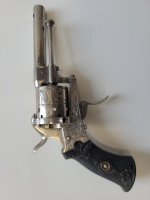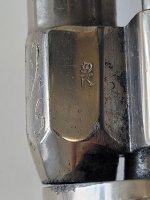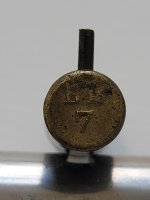The attached pix show a family 7mm pinfire revolver that likely arrived in the USA along with German or Swedish maternal ancestors in the mid to late 1800s.
While it certainly looks like a Lefaucheaux design, its only marking is a crown over K symbol.
Any ideas as to the origin of the revolver?
Does the ammo (it came to me with 5 rounds, so I assume it was fired at least once) provide any hints?
Any thoughts or reactions are much appreciated!
While it certainly looks like a Lefaucheaux design, its only marking is a crown over K symbol.
Any ideas as to the origin of the revolver?
Does the ammo (it came to me with 5 rounds, so I assume it was fired at least once) provide any hints?
Any thoughts or reactions are much appreciated!




